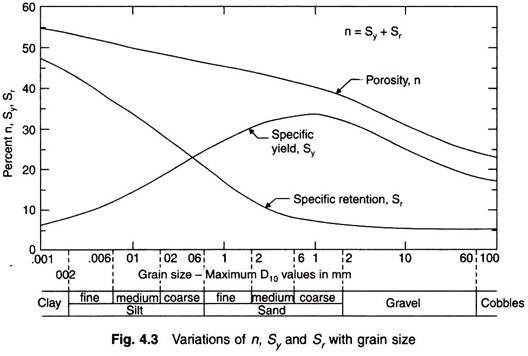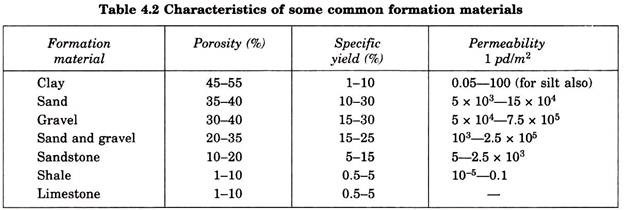ADVERTISEMENTS:
While porosity is a measure of the water-bearing capacity of the formation, all this water cannot be drained by gravity or by pumping from wells, as a portion of the water is held in the void spaces by molecular and surface tension forces. The volume of water, expressed as a percentage of the total volume of the saturated aquifer, that can be drained by gravity is called the specific yield Sy and the volume of water retained by molecular and surface tension forces, against the force of gravity, expressed as a percentage of the total volume of the saturated aquifer, is called specific retention Sr and corresponds to field capacity.
Specific yield is the water removed from unit volume of aquifer by pumping or drainage and is expressed as percentage volume of aquifer. Specific yield depends upon grain size, shape and distribution of pores and compaction of the formation. The values of specific yields for alluvial aquifers are in the range of 10 to 20% and for uniform sands about 30%, Fig. 4.3.
Characteristics of some common formation materials are given in Table 4.2.
Determination of Specific Yield:
(i) Simple Saturation and Drainage:
ADVERTISEMENTS:
Columns of saturated material are drained by gravity and volumes of the material drained and water yielded are determined. The volume of water yielded can be measured directly or can be computed from the porosity and the moisture content after draining.
Specific Yield = Porosity – Specific Retention
(ii) Correlation with Particle Size:
ADVERTISEMENTS:
By determining the effective size or median diameter of the sample and referring to the curve showing the relation between specific retention and effective size or median diameter, the approximate specific retention can be read. The porosity is determined then-
Specific Yield = Porosity – Specific Retention
(iii) Centrifuge Moisture Equivalent (CME):
Considerable experimental work has indicated that for at least some medium textured materials, the moisture equivalent approximates specific retention.
(i) Field Saturation and Drainage:
Similar in principle as the laboratory method.
(ii) Sampling after Lowering of Water Table:
After appreciable lowering of the water table, samples are taken from the zone immediately above the capillary fringe. The moisture content and porosity of the sample are determined.
ADVERTISEMENTS:
Specific Yield = Porosity – Specific Retention
(iii) Pumping Method:
A known volume of water is pumped out and the volume of sediments drained is determined by observing the depth of the water table lowered.
Specific yield = Volume of water pumped out /Volume of sediments drained × 100
Specific yield could also be estimated from moisture content determined by sampling or nuclear meter logging in the cone of depression around a pumped well.
(iv) Recharge Method:
This method is the reverse of the pumping method. The volume of the sediment saturated by the measured recharge is determined and the specific yield is computed.
The specific yield of the soil in the zone of water table fluctuation must be determined in order to estimate the available water supply due to an increment of rise in the water table during the period of recharge, as well as the water supply obtainable for each incremental lowering of the water table.
Example 1:
The following data is obtained from the difficult rocky areas of Southern U.P. (India):
Area (rocky) – 1 km2
Normal rainfall – 700 mm
Normal fluctuation of water table before and after rains – 3.2 m
Specific yield of the rock – 2%
Population – 154/km2
Examine how far the drinking water needs of the local population can be met.
Solution:
Ground water storage available annually-
Q = Area × Depth of fluctuation of g.w.t. × Specific yield 2
= 106 × 3.2 × 2/100 = 64,000 m3
Which can be replenished by normal rainfall whose volume, assuming an infiltration rate of 10% = (1 × 106) × 700/1000 × 10/100 = 70,000 m3 and also as observed by the normal fluctuation of water table. Assuming a per capita consumption of 180 lpd annual drinking water supply required = 154 × 180 × 365 = 10,120,000 litres or 10,120 m3.
The annual drinking water supply required is 10,120 m3 against an availability of 64,000 m3. Thus, there is enough replenishable ground water resource available in the area to meet the drinking water needs of the local population. The only problem is location and economic construction of potential wells.
Example 2:
In a phreatic aquifer extending over 1 km2 the water table was initially at 25 m below ground level. Sometime after irrigation with a depth of 20 cm of water, the water table rose to a depth of 24 m b.g.l. Later 3 × 105 m3 of water was pumped out and the water table dropped to 26.2 m b.g.l. Determine- (i) specific yield of the aquifer, (ii) deficit in soil moisture (below field capacity) before irrigation.
Solution:
Volume of water pumped out = Area of aquifer × drop in g.w.t. × specific yield
3 × 105 = 106 × 2.2 × Sy
Sy = 0.136, or 13.6%
Volume of irrigation water recharging the aquifer = Area of aquifer × rise in g.w.t × Sy Considering an area of 1 m2 of aquifer,
1 × y = 1 × 1 × 0.136
Recharge volume (depth) y = 0.136 m, or 136 mm
Soil moisture deficit (below field capacity) before irrigation = 200 – 136 = 64 mm
Example 3:
In an area of 100 ha, the water table dropped by 4.5 m. If the porosity is 30% and the specific retention is 10% determine- (i) the specific yield of the aquifer, (ii) change in ground water storage.
Solution:
Porosity = Sy + Sr
30% = Sy + 10% Sy = 30 – 10 = 20% or 0.2
Change in ground water storage = Area of aquifer × drop in g.w.t. × Sy
= 100 × 4.5 × 0.2
= 90 ha-m, or 90 × 104 m3


